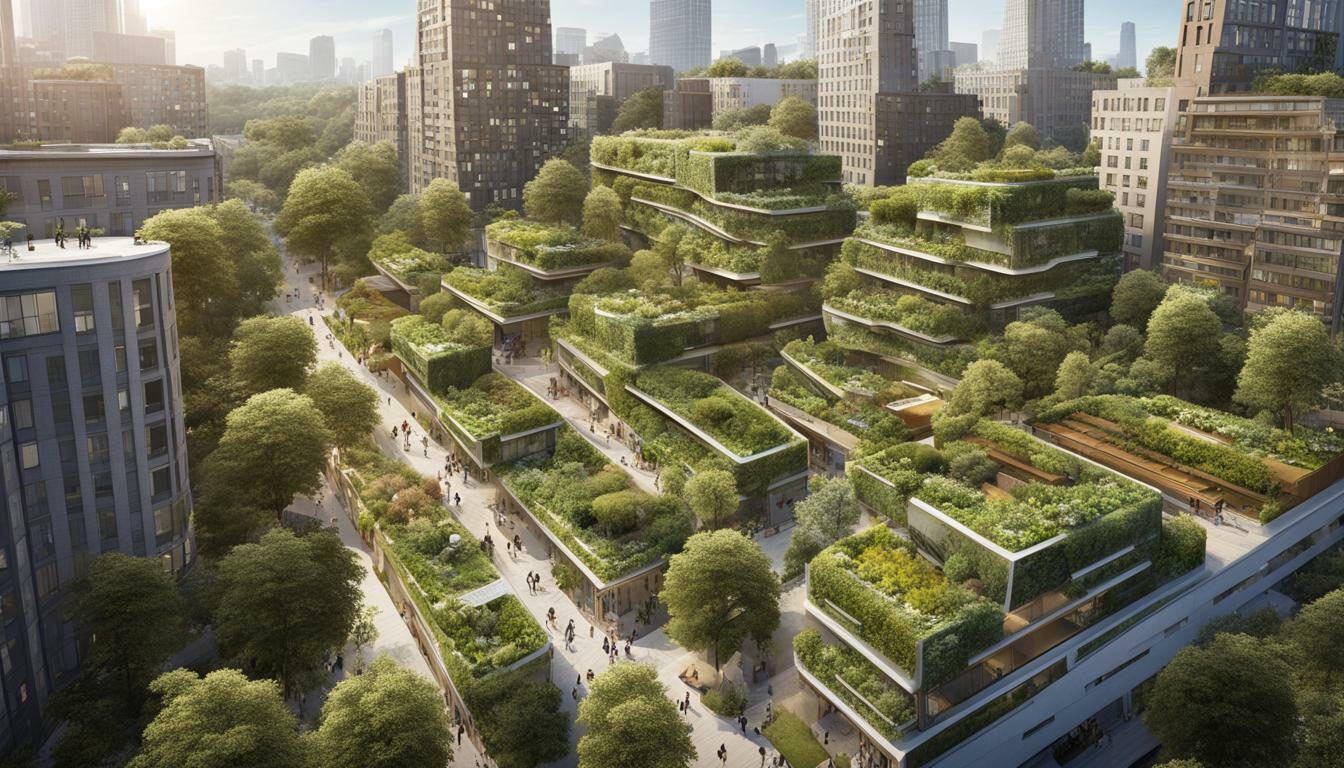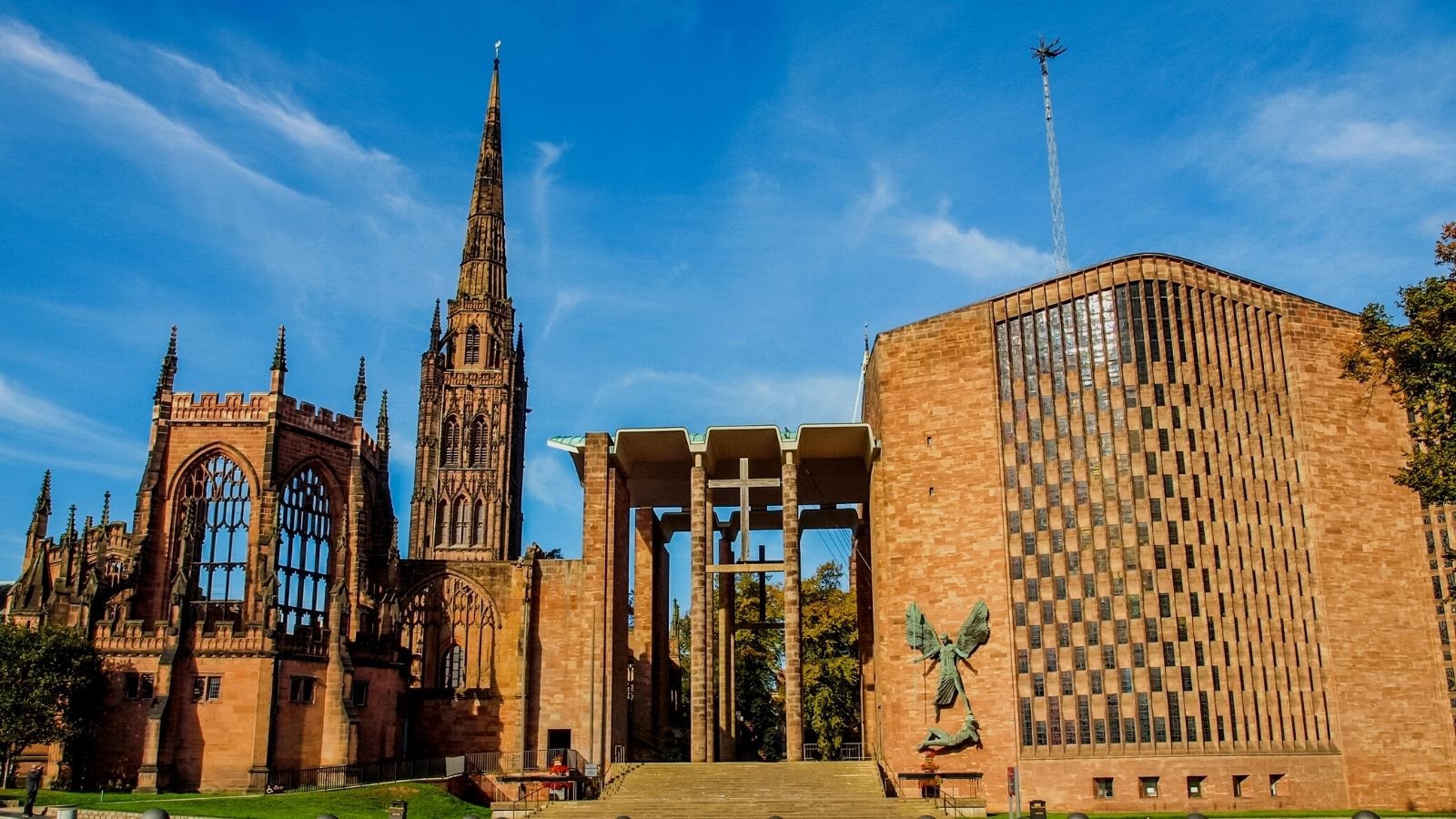Thriving in Balance: Designing Post-Growth Cities for People and Planet
Welcome to our article series on sustainable urban planning. In this series, we will explore the concept of post-growth cities and their importance in creating a sustainable future, as well as innovative approaches to urban design that prioritize the well-being of both people and the planet.
As the world’s population continues to grow and urbanization becomes more prevalent, sustainable urban planning has become crucial to ensure a livable, healthy and prosperous future for all. Designing post-growth cities that prioritize people and the planet is the key to achieving this goal.
Key Takeaways:
- Post-growth cities are essential for creating a sustainable future.
- Urban planning should prioritize the well-being of people and the planet.
- Sustainable design strategies can help achieve a balance between growth and resilience.
Community-Centric Urban Design: Putting People First
Community-centric urban design is a concept that revolves around putting people first in the design of urban spaces. This approach focuses on creating inclusive and vibrant communities that prioritize the needs and well-being of residents.
By prioritizing citizen participation and involvement in the design process, cities can be designed to meet the diverse needs of their inhabitants. This approach ensures that urban spaces are not only functional but also aesthetically pleasing and conducive to healthy living.
The Importance of Inclusivity and Diversity in Urban Design
Inclusivity and diversity are essential principles in community-centric urban design. By creating inclusive urban spaces, diverse communities can thrive, and equality can be promoted within cities. Urban design strategies that prioritize accessibility, affordability, and social cohesion ensure that urban spaces can accommodate everyone, regardless of their background, income, or abilities.
Furthermore, promoting diversity in urban design can also enhance eco-friendly urban living. By fostering inclusive communities, people are more likely to engage in sustainable lifestyles and practices, such as cycling or carpooling.
The Role of Green Spaces in Community-Centric Urban Design
Green spaces, such as parks, gardens, and urban forests, play a crucial role in community-centric urban design. These spaces provide opportunities for people to connect with nature, promote active lifestyles, and improve mental health and well-being. Additionally, green spaces can also mitigate the urban heat island effect and improve air quality.
The image below illustrates how green spaces can be incorporated into urban design:
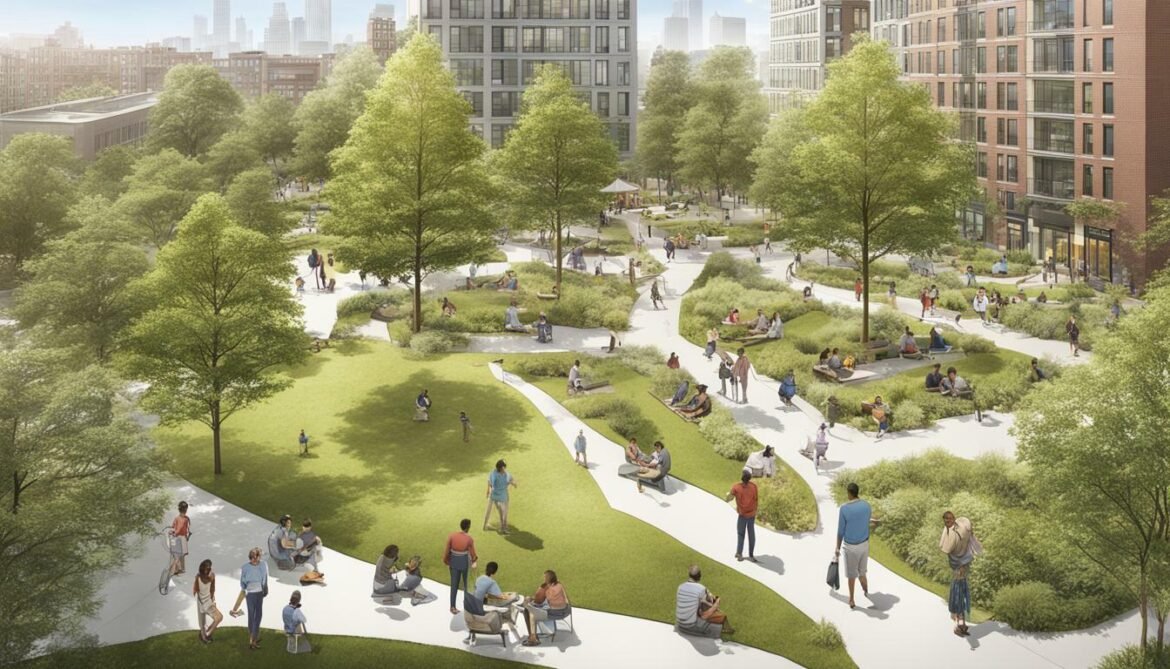
Conclusion
Community-centric urban design is an essential approach to urban planning that puts people first. By involving citizens in the design process, promoting inclusivity and diversity, and incorporating green spaces, cities can be transformed into vibrant and sustainable communities that prioritize the well-being of residents.
Regenerative Urban Infrastructure: Restoring and Sustaining Our Environment
As cities continue to grow, it is becoming increasingly important to develop environmentally conscious city infrastructure that balances urbanization with sustainability. Regenerative urban infrastructure is one such approach that aims to restore and sustain the natural environment while providing essential urban services.
This approach to sustainable city development involves a multi-faceted approach that incorporates green infrastructure, renewable energy systems, and circular economy principles. Green infrastructure, such as parks and gardens, can help mitigate the effects of urbanization by providing natural spaces for wildlife and humans alike. Renewable energy systems, such as solar panels and wind turbines, can reduce dependence on non-renewable energy sources and help mitigate the effects of climate change.
| Benefits of Regenerative Urban Infrastructure |
|---|
| Restoring natural environments |
| Reducing carbon footprint |
| Improving air quality |
| Promoting a more sustainable way of life |
In addition, circular economy principles can help reduce waste and promote a more sustainable way of life. By reusing and recycling materials, cities can minimize their impact on the environment while also fostering economic growth and job creation.
Regenerative urban infrastructure offers a range of benefits, including restoring the natural environment, reducing carbon footprint, improving air quality, and promoting a more sustainable way of life. By incorporating these principles into urban design, we can create cities that thrive while also protecting the planet for future generations.
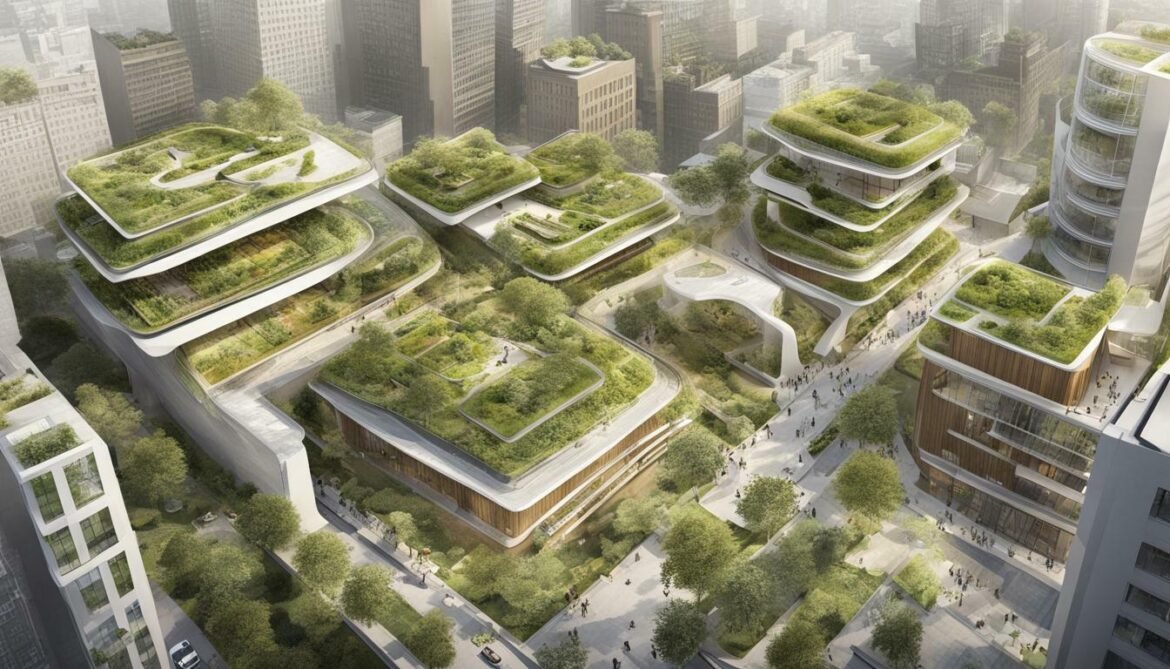
Inclusive Urban Spaces: Fostering Equality and Diversity
Creating inclusive urban spaces that promote equality and diversity is crucial in designing post-growth cities that prioritize the well-being of both people and the planet. In such cities, eco-friendly urban living can flourish, resulting in a reduced carbon footprint and improved quality of life for residents.
One strategy for achieving inclusive urban spaces is prioritizing accessibility and affordability in the design process. This includes providing public transportation that is accessible to all residents, ensuring that affordable housing is available for people of all income levels, and creating public spaces that are easily accessible and welcoming to all.
Citizens’ participation and involvement in the design process is also essential to ensure that cities are designed to meet the diverse needs of their inhabitants. This includes engaging with community groups and actively seeking feedback from residents to ensure that their voices are heard. It is through dialogue and collaboration that we can create inclusive urban spaces that foster equality and diversity.
“Creating inclusive urban spaces that promote equality and diversity is crucial in designing post-growth cities that prioritize the well-being of both people and the planet.”
Moreover, designing eco-friendly urban living spaces can improve social cohesion and promote community building. Incorporating green spaces that encourage outdoor activities and encourage people to come together can help foster a sense of community and belonging. By promoting social cohesion, we can create strong and resilient communities that can adapt to changes and challenges, improving the overall quality of life for people living in post-growth cities.

Sustainable City Planning: Balancing Growth and Resilience
Creating sustainable cities requires a delicate balance between urban growth and resilience. With the global population projected to reach 9.7 billion by 2050, urbanization will continue to be a major trend. Sustainable city planning must be guided by strategies that support both economic growth and environmental sustainability.
Compact development is one such strategy that aims to reduce urban sprawl and preserve natural habitats. By promoting mixed land use, cities can create vibrant communities that offer a range of residential, commercial, and public spaces. This approach can also reduce traffic congestion and air pollution, leading to improved health outcomes for residents.
Resilient infrastructure is another key component of sustainable city planning. This involves designing and building structures that can withstand extreme weather events, such as floods, hurricanes, and earthquakes. By incorporating renewable energy systems, green roofs, and other forms of sustainable infrastructure, cities can reduce their carbon footprint and promote environmental sustainability.

The circular economy is another innovative approach to sustainable city planning. This model seeks to minimize waste and maximize the use of resources by designing products and services with the end goal of reuse and recycling in mind. By adopting circular economy principles, cities can reduce waste, lower greenhouse gas emissions, and promote a more sustainable and resilient future.
The Future of Urban Living: Designing for Sustainability and Well-being
As cities continue to grow, it is important to design urban spaces that prioritize sustainability and the well-being of residents. The integration of nature in urban design, the use of smart technologies, and the promotion of healthy lifestyles are all key components of creating a sustainable future.
One innovative approach to sustainable urban living is the use of green roofs and vertical gardens. These features not only enhance the aesthetic appeal of buildings but also provide a host of environmental benefits, such as improving air quality and reducing the urban heat island effect. Furthermore, they promote a connection with nature that can have positive effects on mental health and well-being.
Smart technologies, such as energy-efficient lighting and automated waste management systems, are also valuable tools in creating sustainable cities. These technologies can reduce energy consumption and promote efficient use of resources, helping to reduce the carbon footprint of urban areas.
Finally, promoting an active and healthy lifestyle is a crucial component of sustainable urban living. Access to public green spaces, pedestrian-friendly streets, and bike lanes can encourage physical activity and reduce reliance on cars, which in turn reduces traffic congestion and emissions.
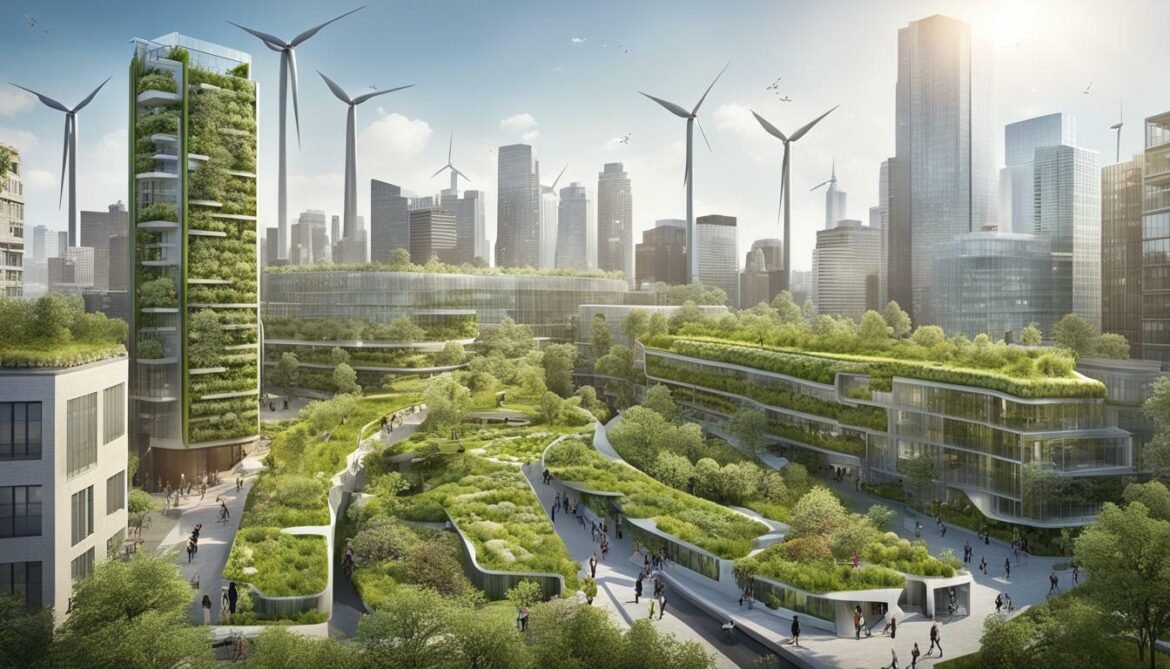
In summary, designing for sustainability and well-being is the future of urban living. By prioritizing nature, technology, and healthy lifestyles, cities can create a more resilient and sustainable future for all.
Conclusion
In conclusion, designing post-growth cities for people and planet is crucial for creating a sustainable future. Through community-centric urban design, regenerative urban infrastructure, inclusive urban spaces, and sustainable city planning, we can create cities that prioritize the well-being of both people and the planet.
It is important to remember that sustainable urban planning is not a one-size-fits-all solution, and must be tailored to meet the unique needs of each city and its inhabitants. This requires citizen participation and collaboration between various stakeholders to ensure that cities are designed to meet the diverse needs of their residents.
As we look towards the future of urban living, it is clear that sustainability and well-being must remain at the forefront of urban design. By integrating nature in urban spaces, promoting healthy lifestyles, and using smart technologies, we can create a future of eco-friendly urban living that benefits both individuals and the planet.
It is our responsibility to continue to innovate and collaborate in sustainable urban planning to create thriving and resilient cities for the future.
FAQ
Q: What are post-growth cities?
A: Post-growth cities are urban areas that prioritize sustainable development and take into account the well-being of both people and the planet. They focus on creating thriving communities and minimizing negative impacts on the environment.
Q: Why are post-growth cities important?
A: Post-growth cities are important because they offer a solution to the challenges posed by urbanization and the need for sustainable development. They promote a balanced approach to urban design that considers social equality, environmental preservation, and economic resilience.
Q: What is community-centric urban design?
A: Community-centric urban design is an approach that prioritizes the needs and well-being of the people who live in a city. It involves involving the local community in the design process and creating inclusive spaces that foster social cohesion and a sense of belonging.
Q: How can regenerative urban infrastructure benefit cities?
A: Regenerative urban infrastructure, such as green infrastructure and renewable energy systems, can benefit cities by restoring and sustaining the natural environment. These practices help mitigate climate change, improve air and water quality, and enhance the overall resilience and sustainability of urban areas.
Q: What are inclusive urban spaces?
A: Inclusive urban spaces are designed to promote equality and diversity. They prioritize accessibility, affordability, and social cohesion, and aim to create a sense of belonging for all residents. Inclusive urban spaces also consider the needs of vulnerable groups and ensure that everyone has equal access to essential services and amenities.
Q: How does sustainable city planning contribute to urban resilience?
A: Sustainable city planning involves balancing urban growth with resilience. This can be achieved through strategies such as compact development, mixed land use, and resilient infrastructure. By incorporating these approaches, cities become better equipped to withstand environmental and social changes and are prepared for future challenges.
Q: What is the future of urban living?
A: The future of urban living is focused on sustainability and well-being. It involves integrating nature into urban design, utilizing smart technologies, and promoting healthy lifestyles. Sustainable urban living offers benefits such as reduced carbon footprint, improved quality of life, and increased resilience to environmental and social challenges.





